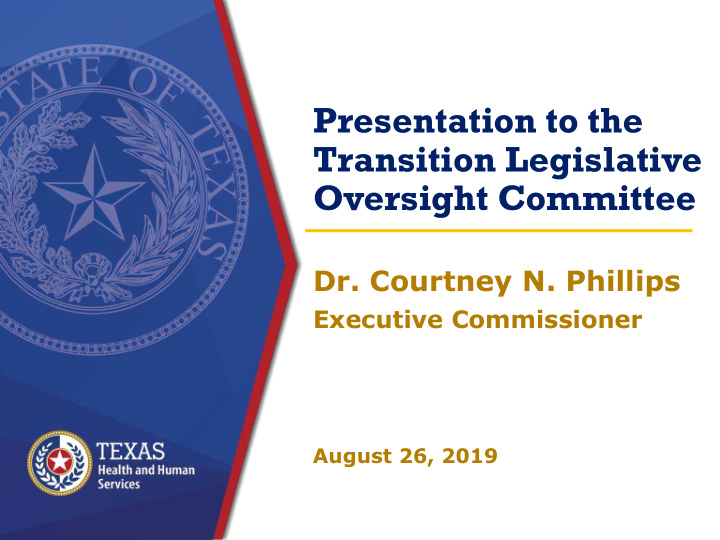



Presentation to the Transition Legislative Oversight Committee Dr. Courtney N. Phillips Executive Commissioner August 26, 2019
Outline • Agency Org Chart • Procurement Update • Regulatory Services Update • HB 1501 (Transfer to Behavioral Health Executive Council) • Health and Specialty Care System and Construction Update • Agency Business Plan 2
3
Procurement Reforms Fiscal Year 2018 • Established new leadership and enhanced organizational structure • Developed new compliance tools • Engaged external entity for independent review • Enhanced policies and procedures • Cleared many audit findings Fiscal Year 2019 • Launched tools to improve workflow • Developed and improved performance metrics • Continued focus on strengthening PCS workforce • Comprehensively reviewed/updated procedures for all types of competitive solicitations • Began implementation of long-term reform projects • Implemented quality control enhancements 4
Continued Opportunities Improving vacancy rates • Clearly delineating lines of authority and responsibility • Further defining the process for developing evaluation criteria • Comprehensively reviewing the Request for Applications (RFA) process • and establishing a dedicated grants team with expertise with RFA solicitations Further revising and streamlining procurement procedures for all types • of competitive solicitations Implementing a comprehensive training plan for PCS and program • staff Enhancing CAPPS Financials • Increasing and improving communication between PCS and customer • organizations (HHSC, DSHS, DFPS) Improving quality assurance through procurement processes • 5
Regulatory Services Division During Transformation, Regulatory Services has undertaken an array of efforts to align functions and processes across its programs: • Complaint Intake : Expanded scope of long-term care (LTC) call center to also field complaints for acute health care facilities (hospitals, etc.) • Operational Support: Stood up new unit to centralize administrative functions (budget, HR etc.) for all five programs, enhancing consistency, efficiency • Licensing : Launched online portal for LTC providers with plans to roll out to other license types • Transformation: Ongoing work with Office of Transformation and Innovation to identify and apply best practices for functions such as enforcement 6
Texas Behavioral Health Executive Council House Bill 1501, 86 th Regular Session, 2019 • Creates the Texas Behavioral Health Executive Council o (BHEC) Consolidates licensing functions of Texas’ behavioral o health licensing boards under BHEC Establishes the Texas Behavioral Health Incubation Task o Force, which includes HHSC, to provide guidance to BHEC on the transfer of these functions Transfer to BHEC • HHSC will transfer 40 FTEs in the following licensing o programs to BHEC by September 1, 2020: Social Workers • Licensed Professional Counselors • Marriage and Family Therapists • Licensing of Chemical Dependency Counselors and Sex o Offender Treatment Providers will remain at HHSC HHSC Regulatory Services and the Office of o Transformation and Innovation are working with internal and external stakeholders to ensure a smooth transition 7
Health and Specialty Care System (HSCS) Improvement Efforts Established in 2017, HSCS is engaged in several improvement and innovation efforts • Rebranded the State Operated Facilities division as the Health and Specialty Care System (HSCS) • Established a business management department to unify business processes and oversight between state supported living centers and state hospitals • Made policy, structure, and system changes to ensure efficiency, improve services • Invested significantly in deferred maintenance 8
HSCS Innovation Changing population, changing needs • Services will be improved through: Standardizing forensic services operating procedures and o competency restoration assessments and programming Centralizing competency restoration evaluations o Providing consultative services to local jails o Coordinating with Medicaid and the community mental o health system to strengthen the continuum of care • Specialized Services Behavioral and psychiatric care will be provided at SSLCs o without the need to transfer residents to state hospitals Terrell State Hospital Forensic Veteran unit o Telemedicine is being used to assist facilities o 9
State Hospital Construction Kerrville SH Renovation • Design completed • Begin abatement: Sept 2019 Add 70-bed MSU • General contractor on-board: Sept Expected groundbreaking: Sept 2019 2019 Planned move-in: Sept 2021 Rusk SH Units • Construction manager-at-risk on- Replace 200-beds, expand MSU board: Sept 2019 Expected groundbreaking: Oct 2019 • Schematic design complete: Sept 2019 Planned move-in: Feb 2022 (MSU); Mar 2024 (non-MSU) San Antonio SH • Design completed Renovation • Begin abatement: Fall 2019 Add 40 beds • General contractor on-board: Fall Expected groundbreaking: Fall 2019 2019 Planned move-in: Apr 2021 UTHealth-Houston • Guaranteed maximum price (GMP) finalized 240-bed Behavioral Health CCC • Began site work: Jun 2019 Groundbreaking: Jun 2019 • Interior design work complete: Sept Planned move-in: Dec 2021 2019 MSU= Maximum Security Unit CCC=Continuum Care Campus 10
State Hospital Construction Additional Austin SH • Initial site work GMP: Sept 2019 Replacement need: • Schematic design complete: Sept 2019 • Begin design development: Sept 2019 ~$124.1M Groundbreaking: Fall 2019 San Antonio SH Additional • Full scale living unit mock-up: Jul 2019 Replacement need: • Design development complete: Sept 2019 Groundbreaking: April • Begin construction documents: Sept 2019 ~$152.4M 2020 11
HHS Annual Business Plan Provides tangible insight into HHS efforts to • continuously improve services and be better stewards of tax dollars Outlines key priorities and initiatives that • will guide the work of HHS in FY 20 and sets measurable, reportable goals Highlights collaboration with stakeholders, • legislative partners, and HHS team members Examples of plan initiatives include • improving health outcomes for women and children, accountability and quality in Medicaid managed care, procurement and contracting processes and outcomes, and the behavioral health continuum of care 12
Recommend
More recommend